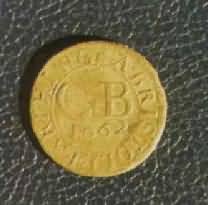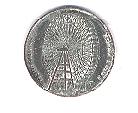|
|
|
The word "token" is derived from the Anglo-Saxon "tacen", for a sign or a symbol . Strictly speaking most of the world's present day coins are tokens for they do not have the full intrinsic value they purport to represent, and are really symbols . However, the commonly accepted numismatic definition of a token is a piece of metal or plastic, resembling a coin in shape, size and type but issued privately , usually without Government authority, for use as a substitute for the official coinage; generally as a pledge to be redeemed either in goods to the value it represents or in corresponding coin of the realm.
Background
to English Tokens
In medieval and early modern Europe the value of a coin was based
on its precious metal content. If a mint used less precious metal
than was required so that the product was under weight or if they
used a more debased metal that was below the required finess,
then the coinage produced would be devalued in relation to other
coinages. To protect English coinage from being devalued due to
unscrupulous minters, the minting of gold and silver coins was
reserved as a royal privilege. Lower denomination coins were made
of the less valuable precious metal, namely silver, which in
England was refined to a .925 fineness called sterling. The
silver penny was the smallest size coin of sterling fineness that
the monarch could reasonably issue. Mossman has calculated if
Elizabeth I were to have made sterling silver farthings they
would have weighed only two grains each! Clearly such a small
size would be difficult to produce and almost impossible to use.
However, small change under a penny denomination was needed for
daily purchases. For such coins to be a usable size they would
need to be made out of a base metal. But, even if they were made
of one of the more expensive base metals, as copper, the coins
would need to be large (under Elizabeth I a halfpenny would need
to be over 175 grains) if they were to have an intrinsic value
equal to their face value. This would also make them costly to
produce. Alternatively, small change coins could be made of base
metal but in a somewhat smaller and usable size, that was
economic to produce. This would mean their intrinsic value would
be less than their face value, so they would have only a token
status. As tokens, their use at face value would be dependent on
local acceptance. The resolution of this problem was, those
people who needed small change the most, namely the local
merchants, produced small change token pieces and used them in
their daily commerce. The public knew the tokens would be
accepted by the local merchants who were issuing them, so they
had confidence in accepting and using the tokens at face value to
make local purchases. These privately produced token coins were
made of lead, tin and even leather. A large number of such pieces
were in circulation through the reign of Elizabeth I.
The
Patent Farthings 1613-1642
On May 19, 1613 James issued a proclamation prohibiting private
token coinage and granting John Harrington, Lord of Exton, a
royal patent to produce copper farthing tokens which were to be
used throughout the realm. Lord Harrington and the king hoped to
share sizable profits from this enterprise. The coins were
authorized to be just six grains but the first products actually
weighed only five grains. Because of protests over the minute
size of these tokens the weight was increased to nine grains.
These copper coins, which displayed a crown and crossed sceptres
on the obverse with a crowned harp on the reverse, were extremely
small and easily counterfeited. Of the three Harrington varieties
two were very small (12.25mm) and were plated with tin, the third
variety was larger (15mm) and issued in copper without plating.
When Lord Harrington died in 1614 the patent passed to his son,
who died soon thereafter, so the patent reverted to Lord
Harrington's wife, Lady Anne Harrington. It appears Lady
Harrington either sold or gave the patent to the Duke of Lennox
for on June 28, 1614 the patent passed to Lodewiche, Duke of
Lennox, who took on the tite of the Duke of Richmond in 1623. The
five varieties emitted during Lodewiche's life are called the
Lennox issues. Thus the Harrington and Lennox farthings date to
the reign of James 1 (1603-1625).
Upon the death of Lodewich in February of 1624 the title passed
jointly to his wife Frances, Duchess of Richmond and Sir Francis
Crane. This partnership began issuing farthings during the reign
of Charles I (1625-1649); in all they emitted eight varieties
known as the Richmond or Royal farthings. On June 20, 1634 the
Duchess passed the patent to Henry Howard, Lord Maltravers, who
began producing farthings in partnership with the same Sir
Francis Crane. This partnership produced six varieties, in the
same style as the previous issues, known as the Maltravers
farthings. The public regularly protested that the patentees were
profiteers producing extraordinarily lightweight coins that were
frequently counterfeited. In fact, Maltravers refused to accept
tokens of earlier patentees, stating too many counterfeits were
in circulation. This caused great economic hardship on the poor
who held the tokens. To stop counterfeiting Maltravers introduced
a smaller and thicker coin with a brass plug in the centre called
a Rose farthing, after the image on the reverse which was changed
from a harp to a rose. Seven varieties of Rose farthings were
issued. In 1642 when the Puritans took control of the Parliament
the coining monopoly was abolished and the minting of the patent
farthings ceased.
Some of these small patent farthings have been uncovered in the
excavation of Wolstenholme Towne, one of the small settlements
outside of Jamestown that was destroyed during a major Indian
attack in 1622. Others were uncovered at Jamestown, the River
Creek site in York County, VA and at what is known as the "Chesapean
Site" at Virginia Beach. Although many people disliked these
tokens it appears they were sought in the Jamestown area. In fact,
in 1636 the Governor of the plantation, John Harvey, petitioned
James I for a supply of the farthing tokens so he could pay day
labourers. However, it appears the request was not granted. A few
of these tokens must have also been brought to Massachusetts Bay,
where the Puritans did not want to have anything to do with the
hated coins. Indeed, they preferred to use musket balls to these
lightweight products of the profiteers.
 |
Lead tokens are not
exactly scarce detector finds, but at the same time they
are not something that you recover on every outing. Those
dating to the 17th and 18th centuries are more numerous
than the medieval or Tudor examples, but nevertheless
each has a special place in our history.Unfortunately,
lead is a poor survivor both in terms of its softness (and
therefore it might suffer damage in use), and also from
its rapid oxidisation and decomposition in the ground.
This begs the question as to why it enjoyed such
widespread use by our ancestors, going back at the very
least to Roman times. The answer is that it was cheap,
readily available, easy to work, and had a low melting
point. It was easy to mould or stamp with the most
primitive of equipment, and if a mistake was made during
manufacture the lead could go straight back into the
melting pot to be recycled and used again. Some of the known examples of 17th and 18th century tokens have initials on them, these occasionally being mirror-reversed. A rare few sometimes carry a date (ie 1694) usually with initials above.Research has shown that these initials normally relate to the landowner, who would have originally owned and worked the property on which they were found. This carries the implication that they would have been given to casual farm workers as tallies for work carried out, and could have been used at the end of a period of time to purchase supplies from the landowner or be redeemed with him against coins of the realm. However, there are many lead tokens that, although they carry a variety of designs, do not have initials. Possibly these could have been used on a number of farms, within an area, as tallies or currency.The whole situation, though, remains something of a mystery and perhaps we will never know the exact use of these pieces. |
 |
This is a farthing token struck by the City of Bristol. The date of 1662 is visible, as is the inscription A BRISTOLL FARTHING. These tokens were regional currency, and are said to have only been legal tender within about a 10-mile radius of Bristol, which is perhaps why it was discarded here in Dorset. |
 |
|
 |
Token Coin Token showing Gigantinc Wheel at Earls Court 1899. The reverse side says:- The Gigantic Wheel at Earls Court is 284 feet in diameter and weighs about 908 tons there are 40 cars each to carry 30 persons from the top of the wheel about 300 feet Windsor Castle is visable on the west. |
The Find Pages And Other Links